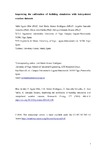Mostrar o rexistro simple do ítem
Improving the calibration of building simulation with interpolated weather datasets
| dc.contributor.author | Eguía, Pablo | |
| dc.contributor.author | Alonso Rodríguez, Jose María | |
| dc.contributor.author | Saavedra, Ángeles | |
| dc.contributor.author | Arce Fariña, Elena | |
| dc.contributor.author | Granada, Enrique | |
| dc.date.accessioned | 2024-01-19T18:22:40Z | |
| dc.date.available | 2024-01-19T18:22:40Z | |
| dc.date.issued | 2018-02-06 | |
| dc.identifier.citation | Eguía Oller, P., Alonso Rodríguez, J. M., Saavedra González, Á., Arce Fariña, E., & Granada Álvarez, E. (2018). Improving the calibration of building simulation with interpolated weather datasets. Renewable Energy, 122, 608-618. https://doi.org/10.1016/j.renene.2018.01.100 | es_ES |
| dc.identifier.issn | 1879-0682 | |
| dc.identifier.uri | http://hdl.handle.net/2183/35021 | |
| dc.description | Manuscrito aceptado | es_ES |
| dc.description.abstract | [Abstract]: The building sector offers huge potential for energy savings, which helps to achieve environmental objectives and social benefits. A good approach to determine both the energy consumption of new buildings and the energetic refurbishment of existing buildings is through thermal simulation. This paper studies how building energy simulation calibration can be improved using interpolated weather data to determine on-site meteorological parameters at the building location. The lack of precise meteorological data in the exact location of buildings means that data from nearby stations is generally used, not knowing how far the error spreads in the results of heating demands and loads. The novelty of this paper lies in the analysis of error propagation to the results of demands and loads of thermal simulation, as well as in the method used to reduce these errors by TPS interpolation. As an interesting conclusion, the average (CV(RMSE)) obtained in the simulation of the studied building, placed successively in each one of the 70 meteorological station locations, decreases from 74% when using the nearest neighborhood to each site to 26% using the TPS interpolation technique. The error in the building simulations is almost three times lower using the studied method. | es_ES |
| dc.description.sponsorship | We would like to thank for the meteorological database to Spanish State Meteorological Agency (AEMET). This investigation article was partially supported by the Spanish Government (Project: ENE2015-65999-C2-1-R). This investigation article was partially supported by the Spanish Government (Economy and Competitiveness Spanish Ministry), through the CDTI center (Industrial Technology Development Centre), and European FEDER 2007 - 2013 Technological Fund (European Regional Development Fund) (Project: IDI-20150503). | es_ES |
| dc.language.iso | eng | es_ES |
| dc.publisher | Elsevier | es_ES |
| dc.relation | info:eu-repo/grantAgreement/MINECO/Plan Estatal de Investigación Científica y Técnica y de Innovación 2013-2016/ENE2015-65999-C2-1-R/ES/INVESTIGACION Y DESARROLLO DE TECNICAS DE CALIBRACION Y OPTIMIZACION MULTIOBJETIVO AUTOMATIZADOS APLICADO A SIMULACION DE MODELOS ENERGETICOS EN EDIFICACION | es_ES |
| dc.relation | info:eu-repo/grantAgreement/MINECO/Plan Estatal de Investigación Científica y Técnica y de Innovación 2013-2016/ IDI-20150503/ES/HERRAMIENTA DE CONTROL METEOROLÓGICO PARA LA SIMULACIÓN TÉRMICA PARA LA CONSTRUCCIÓN Y EL CONTROL AMBIENTAL | es_ES |
| dc.relation.uri | https://doi.org/10.1016/j.renene.2018.01.100 | es_ES |
| dc.rights | © 2018. This manuscript version is made available under the CC-BY-NC-ND 4.0 license https://creativecommons.org/licenses/by-nc-nd/4.0/ | es_ES |
| dc.rights.uri | http://creativecommons.org/licenses/by-nc-nd/3.0/es/ | * |
| dc.subject | Building simulation | es_ES |
| dc.subject | Weather data | es_ES |
| dc.subject | Interpolation | es_ES |
| dc.subject | Thin plate spline | es_ES |
| dc.title | Improving the calibration of building simulation with interpolated weather datasets | es_ES |
| dc.type | info:eu-repo/semantics/article | es_ES |
| dc.rights.access | info:eu-repo/semantics/openAccess | es_ES |
| UDC.journalTitle | Renewable Energy | es_ES |
| UDC.volume | 122 | es_ES |
| UDC.startPage | 608 | es_ES |
| UDC.endPage | 618 | es_ES |
| dc.identifier.doi | https://doi.org/10.1016/j.renene.2018.01.100 |
Ficheiros no ítem
Este ítem aparece na(s) seguinte(s) colección(s)
-
GI-CTC - Artigos [75]






